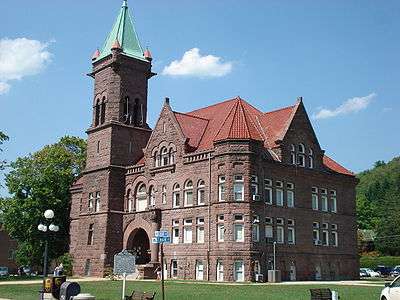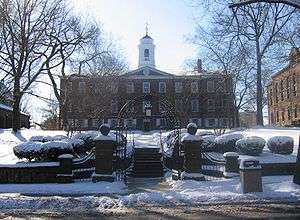Brownstone
Brownstone is a brown Triassic-Jurassic[1][2] sandstone which was once a popular building material. The term is also used in the United States to refer to a townhouse clad in this material.
Types

Apostle Island brownstone
In the 19th century, Basswood Island, Wisconsin, was the site of a quarry run by the Bass Island Brownstone Company which operated from 1868 into the 1890s. The brownstone from this and other Apostle Islands quarries was in great demand, and brownstone from Basswood Island was used in the construction of the first Milwaukee County Courthouse in the 1860s.[3]
Hummelstown brownstone
Hummelstown brownstone is extremely popular along the East Coast of the United States of America, with numerous government buildings from West Virginia, Pennsylvania, New York, Maryland, and Delaware being faced entirely with the stone. The stone comes from the Hummelstown Quarry in Hummelstown, Pennsylvania, a small town outside of Harrisburg, Pennsylvania. The Hummelstown Quarry is the largest provider of brownstone on the east coast. Typically the stone was transported out of Hummelstown through the Brownstone and Middletown Railroad or taken by truck up to the Erie Canal.
Portland brownstone
Portland brownstone, aka Connecticut River Brownstone, is also very popular. The stone from quarries located in Portland, Connecticut, and nearby localities was used in a number of landmark buildings in Chicago; Boston; New York City; Philadelphia; New Haven, Connecticut; Hartford, Connecticut; Washington, D.C.; and Baltimore.
New Jersey brownstone

Quarries from the Passaic Formation in northern New Jersey once supplied most of the brownstone used in New York City and in the state of New Jersey.[4]
South Wales brownstone
Devonian aged sandstones commonly used in South Wales, United Kingdom
Use in urban private residences

There are many brownstones throughout numerous New York City neighborhoods, especially in the Brooklyn neighborhoods of Park Slope, Clinton Hill, Fort Greene, Cobble Hill, Prospect Heights, Brooklyn Heights, Bedford Stuyvesant, Sunset Park and Bay Ridge. The Manhattan neighborhood of the Upper West Side, too, retains many brownstones. Brownstones also predominate in some Hudson County neighborhoods directly across the Hudson River from Manhattan, especially in Hoboken[5] and around Van Vorst Park and Hamilton Park in Jersey City.[6] New York City brownstones usually cost several million dollars to purchase. A typical architectural detail of brownstones in and around New York City is the stoop, a steep staircase rising from the street to the entrance on what amounts to almost the second-floor level. This design was seen as hygienic at the time many were built, because the streets were so mucky from animal waste.[7]
Lately, it has become fashionable to use the term "brownstone" to refer to almost any townhouse from a certain period, even though they may not have actually been built of brownstone. Many townhouses in Boerum Hill, Brooklyn, for example, are basically built of brick, some having concrete masonry cladding to make them resemble actual stone.
The Rittenhouse Square and Fairmount, Philadelphia neighborhoods of Philadelphia also include examples of brownstone architecture. Many of these homes have been converted into apartment buildings.

Back Bay, Boston, is known for its Victorian brownstone homes — considered some of the best-preserved examples of 19th-century urban design in the United States.[8]

Although some brownstones exist in Chicago, a similar residential form known as "greystones" are by far more prevalent. A greystone is a type of residential structure that utilizes Indiana limestone for its facade, regardless of its overall architectural style. As in Brooklyn, there exists a "Greystone Belt" in Chicago, with large numbers of such structures located in the south and northwest quadrants of the city. It is estimated that around 30,000 of Chicago's greystones built between 1890 and 1930 are still standing.[9]
Use in colonial country homes
Brownstone, also known as freestone due to its durability and advantages as a building material, was used by early Quakers in Pennsylvania to construct stone mills and mill houses. In central Pennsylvania, some 1700s-era structures survive, including one still used as a residence, known as the Quaker Mill House.
See also
- Besançon, France, noted for building façades made of stone from Chailluz Quarry
- Dimension stone
- Greystone
- Hummelstown Brownstone Company
- Railroad apartment
- Sandstone
References
- ↑ Muessig, Karl W. (2007). "Unearthing New Jersey" (PDF). New Jersey Geological Survey Newsletter. 3 (1): 1. Retrieved 12 December 2014.
- ↑ Garrison, Ervan G.; Herz, Norman (1998). Geological methods for archaeology. New York: Oxford University Press. p. 205. ISBN 9780198025115. Retrieved 12 December 2014.
- ↑ NPS.gov: Stone Quarries of the Apostle Islands
- ↑ "NJDEP-SEEDS-State Rock". State.nj.us. 2007-09-06. Retrieved 2012-05-04.
- ↑ forgotten-ny.com/2003/09/meeting-across-the-river-hoboken-nj/
- ↑ http://forgotten-ny.com/2013/07/van-vorst-park-jersey-city/
- ↑ Levine, DB (September 2007). "The Hospital for the Ruptured and Crippled moves east on 42nd Street 1912 to 1925". HSS J. 3: 131–6. doi:10.1007/s11420-007-9051-6. PMC 2504267
 . PMID 18751783.
. PMID 18751783. - ↑ Jolly, Joanna (27 October 2014). "How Boston is rethinking its relationship with the sea". BBC Magazine. Retrieved 2 March 2015.
- ↑ "What is a Greystone? | Neighborhood Housing Services of Chicago". Nhschicago.org. Retrieved 2013-02-16.
External links
- Website devoted to the"Apostle Island brownstone quarries". Archived from the original on 2006-08-13. Retrieved 2006-07-30. in Wisconsin.
- Website devoted to the Weser brownstone quarries from Germany being imported into the US.
- "After Fight, a Brooklyn Brownstone's Costly Rescue," The New York Times (March 31, 2010)
- Website devoted to the colonial-era Quaker Mill House in Pennsylvania